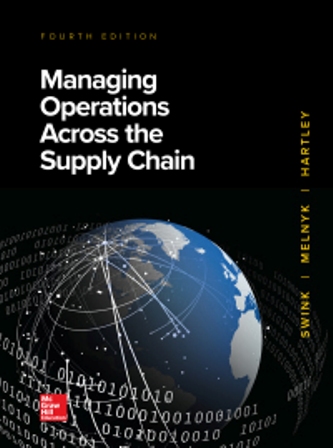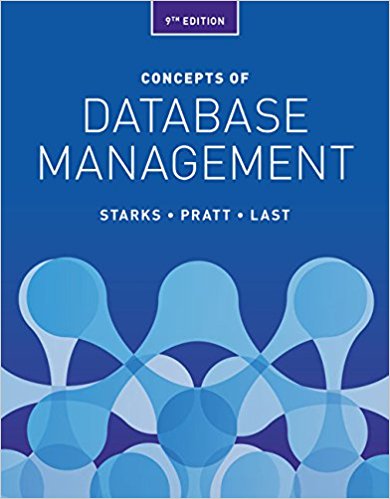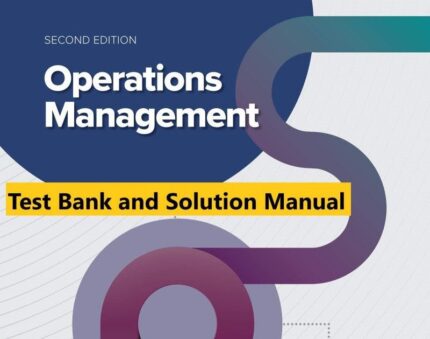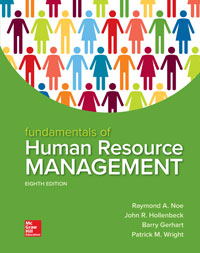Solution Manual for Principles of Operations Management 10th Edition by Heizer
C H A P T E R 1
Operations and Productivity
DISCUSSION QUESTIONS
1. The text suggests four reasons to study OM. We want to understand (1) how people organize themselves for productive enterprise,
(2) how goods and services are produced, (3) what operations
managers do, and (4) this costly part of our economy and most
enterprises.
2. Possible responses include: Adam Smith (work specialization/division of labor), Charles Babbage (work specialization/division
of labor), Frederick W. Taylor (scientific management), Walter Shewart (statistical sampling and quality control), Henry Ford (moving
assembly line), Charles Sorensen (moving assembly line), Frank and
Lillian Gilbreth (motion study), Eli Whitney (standardization).
3. See references in the answer to question 2.
4. The actual charts will differ, depending on the specific organization the student chooses to describe. The important thing is
for students to recognize that all organizations require, to a greater or lesser extent, (a) the three primary functions of operations,
finance/accounting, and marketing; and (b) that the emphasis or
detailed breakdown of these functions is dependent on the specific competitive strategy employed by the firm.
5. The answer to this question may be similar to that for question 4.
Here, however, the student should be encouraged to utilize a more
detailed knowledge of a past employer and indicate on the chart
additional information such as the number of persons employed to
perform the various functions and, perhaps, the position of the
functional areas within the overall organization hierarchy.
6. The basic functions of a firm are marketing, accounting/
finance, and operations. An interesting class discussion: “Do all
firms/organizations (private, government, not-for-profit) perform
these three functions?” The authors’ hypothesis is yes, they do.
7. The 10 decisions of operations management are product design, quality, process, location, layout, human resources, supplychain management, inventory, scheduling (aggregate and short
term), maintenance. We find this structure an excellent way to
help students organize and learn the material.
8. Four areas that are important to improving labor productivity
are: (1) basic education (basic reading and math skills), (2) diet of
the labor force, (3) social overhead that makes labor available
(water, sanitation, transportation, etc.), and (4) maintaining and
expanding the skills necessary for changing technology and
knowledge, as well as for teamwork and motivation.
9. Productivity is harder to measure when the task becomes
more intellectual. A knowledge society implies that work is more
intellectual and therefore harder to measure. Because the U.S. (and
many other countries) are increasingly “knowledge” societies,
productivity is harder to measure. Using labor hours as a measure of productivity for a postindustrial society vs. an industrial or
agriculture society is very different. For example, decades spent
developing a marvelous new drug or winning a very difficult legal
case on intellectual property rights may be significant for postindustrial societies, but not show much in the way of productivity
improvement measured in labor hours.
10. Productivity is difficult to measure because precise units of
measure may be lacking, quality may not be consistent, and
exogenous variables may change.
11. Mass customization is the flexibility to produce in order to
meet specific customer demands, without sacrificing the low
cost of a product oriented process. Rapid product development is
a source of competitive advantage. Both rely on agility within
the organization.
12. Labor productivity in the service sector is hard to improve
because (1) many services are labor intensive and (2) they are
individually (personally) processed (the customer is paying for
that service—the hair cut), (3) it may be an intellectual task performed by professionals, (4) it is often difficult to mechanize and
automate, and (5) often difficult to evaluate for quality.
13. Taco Bell designed meals that were easy to prepare; with
actual cooking and food preparation done elsewhere; automation
to save preparation time; reduced floor space; manager training to
increase span of control.
ETHICAL DILEMMA
With most of the ethical dilemmas in the text, the instructor
should generate plenty of discussion with this dilemma. The
authors are hesitant to endorse a particular correct answer. And
students may well be on both side of this dilemma.
Many students will be inclined to accept the child labor laws
of their home country. For instance, Americans accept teenagers
working. But Germans (and others) are more likely to expect
teenagers to be home studying or in an apprentice program; they
frown upon teenagers working. Students raised in more affluent
environments may not understand children working. However,
those who had to scrape by in their youth or had parents that did
may be more sympathetic to 10-year-olds working.
From an economic and self-preservation perspective many
10-year-olds do work and need to work. There are still a lot of
poor people in the world. Such a decision may endorse the moral
philosophy perspective defined as a Utilitarianism decision.
A utilitarianism decision defines acceptable actions as those that
maximize total utility, i.e., the greatest good for the greatest
number of people.
2 CHAPTER 1 OP E R A T I O N S A N D P R O D U C T I V I T Y
6.6 (c) Increase in productivity = = 33.0% 20
From a U.S. corporate management perspective, companies
cannot tolerate the publicity that goes with hiring 10-year-olds.
These companies need to have standards that prohibit such
actions by their subcontractors. The moral philosophy perspective might call this the virtue ethics position—the decision
that a mature person with a good moral character would deem
correct.
END-OF-CHAPTER PROBLEMS
120 boxes (a) = 3.0 boxes/hour 40 hours
1.1
125 boxes (b) = 3.125 boxes/hour 40 hours
(c) Change in productivity = 0.125 boxes/hour
(d) 0.125 boxes Percentage change = = 4.166%
3.0
1.2 (a) Labor productivity is 160 valves/80 hours = 2 valves
per hour.
(b) New labor productivity = 180 valves / 80 hours = 2.25
valves per hour
(c) Percentage change in productivity = .25 valves / 2
valves = 12.5%
1.3
So 57,600 L = = 200
(160)(12)(0.15) laborers employed
1.4 Bureau of Labor Statistics (stats.bls.gov) is probably as
good a place to start as any. Results will vary for each year, but
overall data for the economy will range from .9% to 4.8% and
mfg. could be as high as 5% and services between 1% and 2%.
The data will vary even more for months or quarters. The data are
frequently revised, often substantially.
Units produced 100 pkgs (a) = = 20 pkgs/hour Input 5
1.5
133 pkgs (b) = 26.6 pkgs per hour 5
[(1,000/4,850) (1,000/4,510)]
(1,000/4,850)
− =
0.206–0.222 –0.016 = = 0.078 fewer resources 0.206 0.206
⇒ 7.8% improvement*
* with rounding to 3 decimal places.
Output Productivity = Input











